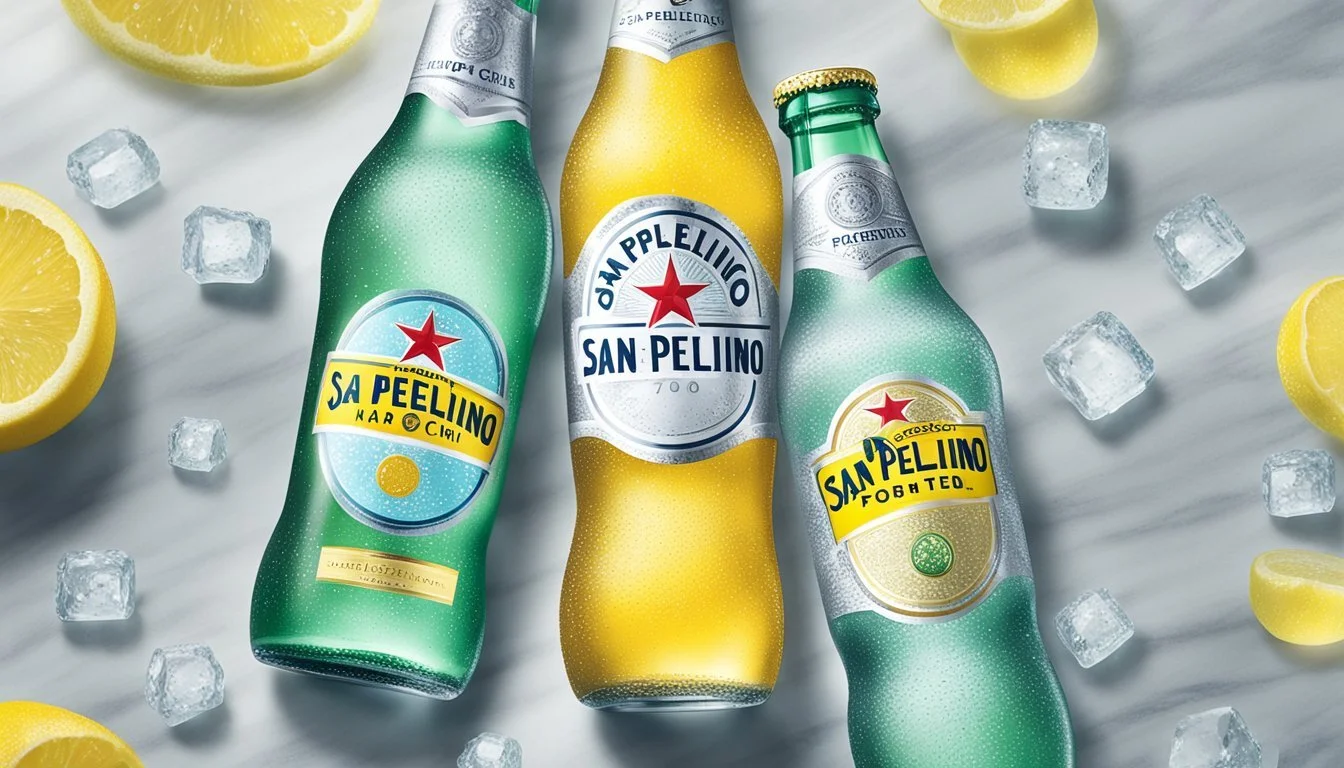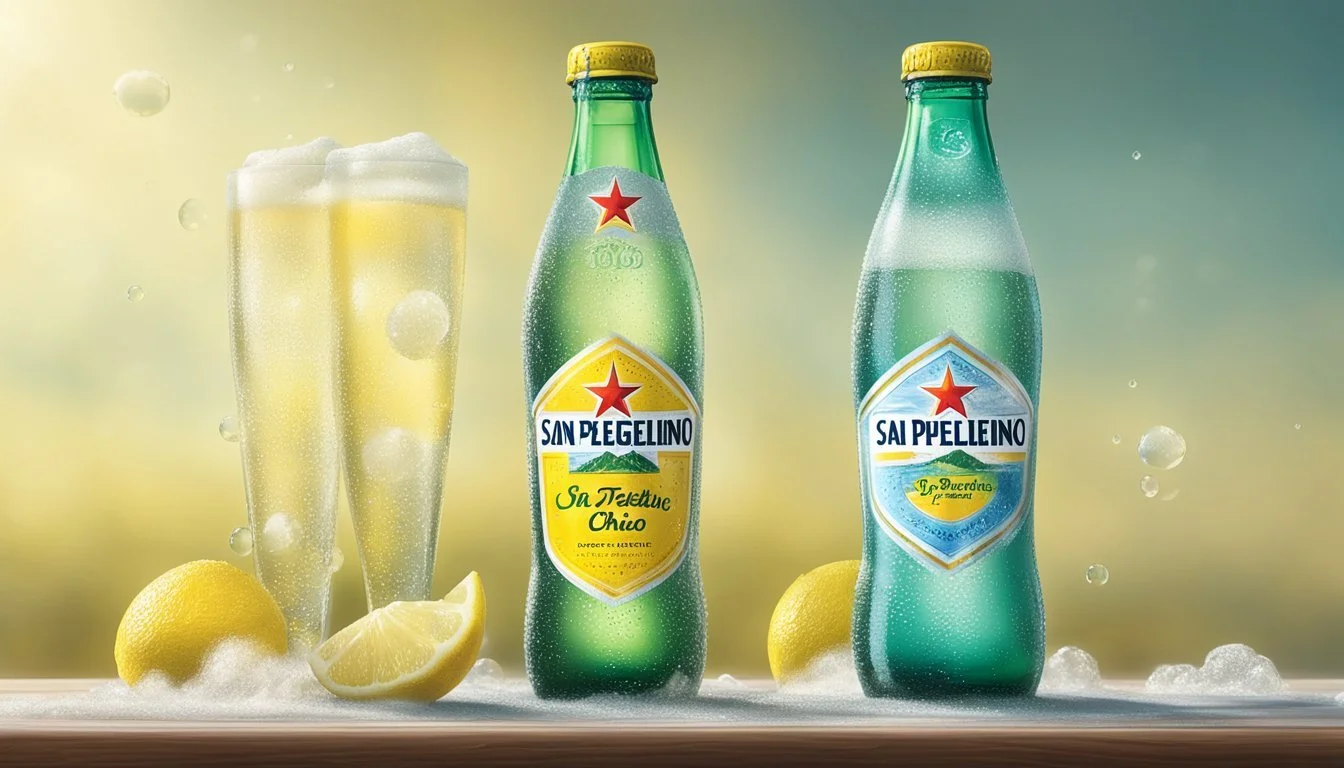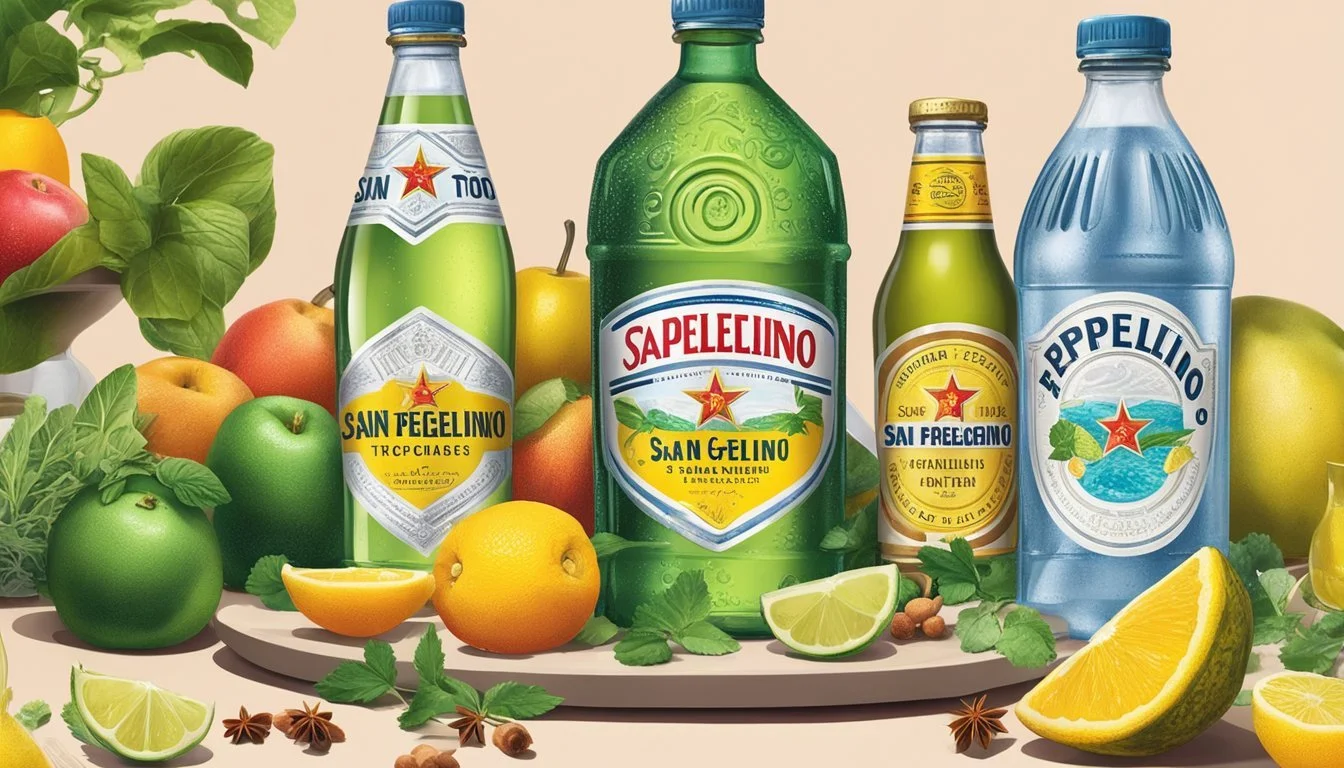San Pellegrino vs. Topo Chico
Comparing Premium Sparkling Waters
In the rapidly expanding world of bottled sparkling waters, San Pellegrino and Topo Chico emerge as notable contenders. San Pellegrino, sourced from the springs in the Italian Alps, has been a staple in the market known for its fine bubbles and distinctive taste. With a rich heritage that began over a century ago, it stands as a symbol of Italian lifestyle and sophistication.
Topo Chico, by contrast, boasts its own historic charm, originating from the Cerro del Topo Chico spring in Monterrey, Mexico, since 1895. Its unique effervescence and mineral composition have garnered a dedicated following, particularly among those seeking a different level of carbonation and crispness in their sparkling water.
Consumers today are confronted with an array of choices, but the decision between San Pellegrino and Topo Chico often boils down to personal preference in taste, mouthfeel, and the mineral content sought after in a sparkling mineral water. The journey of selecting the superior bottled water is a subjective experience that hinges on the nuanced characteristics that each brand offers.
Origins and History
The storied pasts of San Pellegrino and Topo Chico trace back over a century, each originating from unique and protected underground water sources known for their natural mineral content. These two distinct brands have become synonymous with quality mineral water, celebrated for both their taste and effervescence.
San Pellegrino Terme
San Pellegrino finds its roots in the town of San Pellegrino Terme in Italy, nestled in the Brembana Valley. The water originates from a layer of rock 1,300 feet below the surface, where it is naturally enriched with mineral salts. San Pellegrino was first bottled in 1899, and since then, the brand has been regarded as a prime example of premium natural mineral water.
Topo Chico's Beginnings
Topo Chico mineral water has been sourced from the springs at the foot of the Cerro del Topo Chico, in Northern Mexico. The company's foundation stretches back to 1895, with the water's quality attributed to the interaction with minerals from the surrounding volcanic mountains. The water is bottled directly at the source, ensuring its freshness and mineral composition remain intact.
Physical and Chemical Properties
San Pellegrino and Topo Chico bottled waters differ in their mineral content, carbonation levels, and the materials used in their packaging. These factors can influence the taste and perceived quality of the water.
Mineral Content Comparison
San Pellegrino's water is naturally enriched with calcium, magnesium, and bicarbonate, which contribute to its distinctive taste. It is sourced from springs in the Italian Alps and is known for its balanced mineral content which includes major minerals such as:
Calcium (Ca): Essential for bone health.
Magnesium (Mg): Crucial for muscle function.
Bicarbonate (HCO3): Imparts a slight alkaline taste.
Topo Chico, originating from Mexico, also boasts a robust mineral profile that consists of minerals like calcium and magnesium, but it has a higher presence of bicarbonate. This results in a slightly different taste and mouthfeel. The mineral content specifically includes:
Calcium (Ca): Instrumental for bone strength.
Magnesium (Mg): Supports energy production.
Bicarbonate (HCO3): Enhances the crisp taste.
Carbonation and Bubbles
The level of carbonation in San Pellegrino and Topo Chico gives these waters their lively effervescence. San Pellegrino typically has less carbonation compared to Topo Chico, resulting in softer and finer bubbles. Topo Chico is recognized for its high carbonation levels, creating vigorous and larger bubbles, which some people find enhances their drinking experience.
Bottle Packaging
San Pellegrino is often sold in glass bottles, believed by some consumers to preserve the water's mineral composition and taste better than plastic. Topo Chico is also available in glass bottles but can be found in plastic as well. Glass bottling can be a factor in maintaining the integrity of water's carbonation and preventing the leaching of substances from packaging materials.
Health and Nutritional Information
When considering the health and nutritional aspects of San Pellegrino and Topo Chico, it is important to analyze caloric and sugar content, as well as sodium levels and acidity. These factors are critical in understanding the overall health impact of consuming these beverages.
Caloric and Sugar Content
San Pellegrino:
Calories: 0 per serving
Sugar: 0g per serving
Topo Chico:
Calories: 0 per serving
Sugar: 0g per serving
Both San Pellegrino and Topo Chico are marketed as zero-calorie beverages, which means they contain no sugar and no calories. This makes them suitable options for those monitoring their caloric intake or adhering to a sugar-free diet.
Sodium Levels and Acidity
San Pellegrino Sodium Content:
Sodium: Typically around 30mg per serving
Topo Chico Sodium Content:
Sodium: Generally ranging between 15–35mg per serving
When it comes to their respective sodium levels, San Pellegrino and Topo Chico are both low in sodium. However, their mineral compositions may result in a mild difference in taste. Low sodium content is a beneficial attribute for consumers trying to manage their sodium intake under FDA and EPA guidelines.
Acidity (pH Levels):
San Pellegrino: Mildly acidic
Topo Chico: Mildly acidic
While exact pH levels can vary, both waters posses a level of acidity that is typically safe and falls within regulatory standards. The mild acidity contributes to the characteristic taste of these sparkling waters without significantly affecting the body's natural pH balance.
Flavor Profiles and Culinary Uses
San Pellegrino and Topo Chico are both sparkling mineral waters that serve as palate refreshers and have distinct roles in both culinary and mixology settings.
Tasting Notes
San Pellegrino:
Fizz: Noticeable, but not overpowering carbonation.
Taste: A balance of subtle, complex minerality.
Topo Chico:
Fizz: Intense bubbles that provide a sharp effervescence.
Taste: A bright and crisp profile with a hint of minerality.
Food Pairings
San Pellegrino is traditionally paired with meals to enhance the flavors. It has a refreshing effect on the palate, which makes it suitable for accompanying:
Rich foods: It cuts through the fattiness of dishes like lasagna or creamy pasta.
Citrus-flavored dishes: Elevates the taste with its own subtle citric undertone.
Topo Chico is ideal for spicy and bold cuisines. Its strong carbonation cleanses the palate and complements:
Mexican Cuisine: Such as tacos or ceviche.
Barbecue: The effervescence contrasts well with smoky flavors.
Uses in Mixology
Both sparkling waters are staples as a cocktail ingredient, not only for their carbonation but also for the subtle flavor profiles they add.
San Pellegrino:
Perfect for cocktails that require a less aggressive fizz.
Often used in light spritzers and wine cocktails.
Topo Chico:
Chosen for cocktails needing a pronounced carbonation that can stand up to strong spirits.
Regularly found in highball drinks or as a topper in tequila-based cocktails.
Consumer Preferences and Perceptions
The consumer's choice between San Pellegrino and Topo Chico often hinges on individual taste preferences and brand perception influenced by marketing strategies and market presence.
Blind Taste Tests
Blind taste tests frequently serve as the ultimate litmus test for consumer preferences regarding bottled sparkling waters. San Pellegrino tends to be favored for its slightly higher fizz content compared to competitors. These outcomes not only reflect subjective palates but can also subtlety shape market demand for what is regarded by some as the best sparkling water experience.
Market Trends
In examining market trends, data suggests a strong consumer shift towards bottled sparkling waters with authentic branding and perceived natural sourcing. Topo Chico, with its mineral-rich profile and vibrant carbonation, has traditionally resonated well within this market, as evidenced by its strong sales and loyalty.
Incremental Growth: San Pellegrino and Topo Chico experience steady growth due to their positioning as premium products.
Consumer Behavior: Trends show a preference for quality and taste over price points in this segment.
Branding and Marketing
Branding and marketing efforts greatly influence consumer perceptions. San Pellegrino's sophisticated image aligns with gourmet dining, while Topo Chico is associated with a more laid-back, culturally rich persona. Packaging, partnerships, and promotions play crucial roles in establishing their market positions.
San Pellegrino: Traditional, high-end branding with a European flair.
Topo Chico: Trendy, vintage-inspired marketing appealing to a younger, dynamic audience.
Environmental and Ethical Considerations
When choosing between San Pellegrino and Topo Chico, consumers may consider the environmental and ethical implications of each brand's sourcing and packaging methods. This section will explore the measures the companies have taken regarding sustainable sourcing and the effectiveness of their recycling initiatives.
Sustainable Sourcing
San Pellegrino sources its mineral water from a protected underground water source in the Italian Alps. The company emphasizes its commitment to preserving the quality and sustainability of the source. In contrast, Topo Chico extracts its water from the Cerro del Topo Chico spring in Mexico. While Topo Chico has reduced certain chemicals in its water to comply with drinking water standards, the extent of its sustainable practices regarding source protection is less documented.
San Pellegrino:
Underground Water Source: Italian Alps
Sustainability Measures: Claims to preserve source
Environmental Impact: Monitored resource extraction
Topo Chico:
Underground Water Source: Cerro del Topo Chico
Sustainability Measures: Compliance with safety standards
Environmental Impact: Less information on sustainability practices
Packaging and Recycling
Packaging decisions by both companies have significant environmental effects, especially concerning the use of plastic and glass, and the efficiency of recycling programs. San Pellegrino predominantly uses glass bottles, which are reusable and more easily recyclable than plastic, though heavier to transport. Topo Chico, on the other hand, offers both glass and plastic options. Recycling becomes a key factor in reducing the environmental impact, yet the effectiveness of recycling efforts varies globally and is dependent upon local infrastructure and consumer participation.
San Pellegrino:
Packaging Materials: Glass (more easily recyclable, heavier)
Recycling: Dependent on local infrastructure
Topo Chico:
Packaging Materials: Glass and plastic options
Recycling: Varies by region; contingent upon consumer behavior
Economic Aspects
When considering the economic aspects of San Pellegrino versus Topo Chico, one must examine the price they are sold at and how readily available they are to the consumer. These factors can significantly influence a buyer's choice depending on their budget and location.
Price Comparison
San Pellegrino and Topo Chico are priced differently depending on the region and the retailer. A standard comparison of prices reveals that:
San Pellegrino: Sold in packs, the price can range from $1.50 to $2 per bottle when purchased in larger quantities.
Topo Chico: Often sold in similar quantities, the pricing for Topo Chico usually falls within the $1 to $1.50 range per bottle.
Price is often dependent on factors such as point of purchase, ongoing promotions, or bulk buying.
Availability and Accessibility
The availability and accessibility of both brands vary:
San Pellegrino is recognized worldwide and is readily available in many supermarkets, restaurants, and online retailers.
Topo Chico has a strong presence in numerous markets but may be less accessible in regions outside of its core areas of distribution, particularly outside of the Americas.
Consumers may find that one brand has broader distribution and easier access in their area, affecting their ultimate choice in sparkling water.
Alternative Sparkling Water Brands
When considering sparkling waters, San Pellegrino and Topo Chico are prominent in the market, but several other brands offer a range of tastes and experiences for consumers.
Popular Competitors
La Croix: A well-known brand in the United States, La Croix offers a wide array of flavored sparkling water choices with no calories, sodium, or artificial sweeteners, catering to health-conscious consumers.
Perrier: With its distinctive green bottle, Perrier is recognized globally. It provides a sharp fizz and is known for its natural emanation from the south of France.
Bubly: This PepsiCo line of flavored sparkling waters has gained popularity for its playful branding and no artificial sweeteners, flavors, or calories.
Polar: As a long-established brand, Polar delivers a range of flavored and unflavored sparkling waters, priding itself on using triple-filtered water.
Voss: Originating from Norway, Voss is known for its sleek, cylindrical packaging and offers both still and sparkling options, including flavored varieties.
Emerging Brands
Liquid Death: The brand stands out for its edgy marketing and tallboy cans, with an aim to "murder your thirst" using 100 percent mountain water.
Recess: Recess infuses sparkling water with hemp extract and adaptogens, targeting those looking for relaxation and stress relief in their beverage options.
Jarritos: Although primarily known for its fruity sodas, Jarritos also produces mineral water, which is carbonated and bottled in Mexico.
Gerolsteiner: A German brand, Gerolsteiner is distinguished by its high mineral content and balanced taste, offering both still and sparkling mineral waters.
Mountain Valley: Coming from the Ouachita Mountains of Arkansas, Mountain Valley sells its spring and sparkling water in glass bottles, emphasizing sustainability and natural purity.





